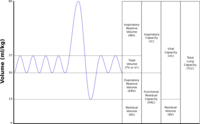
Methacholine challenge test: Comparison of tidal breathing and dosimeter methods in children
Sign Up to like & getrecommendations! Published in 2018 at "Pediatric Pulmonology"
DOI: 10.1002/ppul.23890
Abstract: Methacholine Challenge Test (MCT) is used to confirm, assess the severity and/or rule out asthma. Two MCT methods are described as equivalent by the American Thoracic Society (ATS), the tidal breathing and the dosimeter methods.… read more here.
Keywords: tidal breathing; dosimeter methods; challenge test; methacholine challenge ... See more keywords

Methodological Implications and Repeatability of Nasal Nitric Oxide: Relevance for Challenge Studies.
Sign Up to like & getrecommendations! Published in 2019 at "Advances in experimental medicine and biology"
DOI: 10.1007/5584_2018_166
Abstract: There is an interest in assessing changes in nasal NO (nNO) levels as an effect marker of upper airways. In this study, we examined methodologic influences on short and long term repeatability of nNO levels… read more here.
Keywords: tidal breathing; methodological implications; breath holding; repeatability ... See more keywords

Numerical study of dynamic glottis and tidal breathing on respiratory sounds in a human upper airway model
Sign Up to like & getrecommendations! Published in 2017 at "Sleep and Breathing"
DOI: 10.1007/s11325-017-1588-0
Abstract: BackgroundHuman snores are caused by vibrating anatomical structures in the upper airway. The glottis is a highly variable structure and a critical organ regulating inhaled flows. However, the effects of the glottis motion on airflow… read more here.
Keywords: glottis; tidal breathing; dynamic glottis; respiratory sounds ... See more keywords

Pulmonary blood mass dynamics on 4DCT during tidal breathing.
Sign Up to like & getrecommendations! Published in 2019 at "Physics in medicine and biology"
DOI: 10.1088/1361-6560/aaff7b
Abstract: We previously reported that apparent lung mass varies across the phases of 4D computed tomography (4DCT) images. We hypothesize that these variations correspond to the physiologic changes in pulmonary perfusion induced during normal tidal breathing,… read more here.
Keywords: tidal breathing; pbm; mass; pulmonary blood ... See more keywords

Awake endoscopic assessment of the upper airway during tidal breathing: Definition of anatomical features and comparison with drug‐induced sleep endoscopy
Sign Up to like & getrecommendations! Published in 2020 at "Clinical Otolaryngology"
DOI: 10.1111/coa.13653
Abstract: Awake nasopharyngoscopy is routinely performed in the assessment of patients who require treatment for sleep‐disordered breathing (SDB). However, the applicability and accuracy of Müller's manoeuvre, the main evaluation method for this purpose, are disputable. The… read more here.
Keywords: endoscopic assessment; tidal breathing; awake endoscopic; upper airway ... See more keywords

Tidal breathing flow volume profiles during sleep in wheezing infants measured by impedance pneumography.
Sign Up to like & getrecommendations! Published in 2019 at "Journal of applied physiology"
DOI: 10.1152/japplphysiol.01007.2018
Abstract: Overnight analysis of tidal breathing flow volume (TBFV) loops, recorded by impedance pneumography (IP), has been successfully applied in the home monitoring of children with wheezing disorders. However, little is known on how sleep physiology… read more here.
Keywords: tidal breathing; volume; breathing flow; rem ... See more keywords

A novel device for the measurement of carbon dioxide during tidal breathing in COPD
Sign Up to like & getrecommendations! Published in 2017 at "European Respiratory Journal"
DOI: 10.1183/1393003.congress-2017.pa3013
Abstract: Background: Ambulatory capnometers can be relatively unreliable due to condensation from breath. The development of a new ambulatory capnometer (N-Tidal) brings advantages through a novel optical system that also increases accuracy over the range of… read more here.
Keywords: tidal breathing; copd patients; copd; carbon dioxide ... See more keywords

Measuring lung mechanics of expiratory tidal breathing with non-invasive breath occlusion
Sign Up to like & getrecommendations! Published in 2020 at "BioMedical Engineering OnLine"
DOI: 10.1186/s12938-020-00777-0
Abstract: Background and objective Lung mechanics measurements provide clinically useful information about disease progression and lung health. Currently, there are no commonly practiced methods to non-invasively measure both resistive and elastic lung mechanics during tidal breathing,… read more here.
Keywords: tidal breathing; elastance; resistance; lung mechanics ... See more keywords

Measuring Ventilatory Activity with Structured Light Plethysmography (SLP) Reduces Instrumental Observer Effect and Preserves Tidal Breathing Variability in Healthy and COPD
Sign Up to like & getrecommendations! Published in 2017 at "Frontiers in Physiology"
DOI: 10.3389/fphys.2017.00316
Abstract: The use of a mouthpiece to measure ventilatory flow with a pneumotachograph (PNT) introduces a major perturbation to breathing (“instrumental/observer effect”) and suffices to modify the respiratory behavior. Structured light plethysmography (SLP) is a non-contact… read more here.
Keywords: tidal breathing; slp; pnt slp; variability ... See more keywords